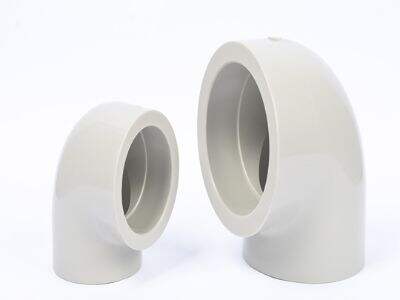Мы склонны представлять трубы как те блестящие металлические, которые можно увидеть снаружи здания (например, трубы для стока воды). Но знали ли вы, что существует гораздо больше типов труб? К ним относятся UPVC и CPVC трубы. Эти трубы производятся из определенного типа пластика, что делает их значительно легче, чем металлические трубы, и поэтому их намного проще транспортировать и устанавливать. Мы знаем, что трубы UPVC и CPVC сделаны из пластика, трубы UPVC также outwardly похожи на трубы CPVC, но между ними есть несколько различий, о которых вам нужно знать.
Что такое трубы UPVC и CPVC?
Разберем это подробнее. Трубы из ПВХ制成 из немодифицированного поливинилхлорида. Это длинное название указывает на то, что пластик очень прочный и жесткий — то есть он мало гнется. Это делает его отличным выбором для некоторых применений, особенно когда требуется, чтобы труба сохраняла свою форму — поскольку она хорошо отличается от других материалов. Однако трубы из СПВХ производятся из химического вещества, известного как хлорированный поливинилхлорид. Этот пластик также очень прочный, но имеет немного больше эластичности, чем ПВХ. Эта дополнительная гибкость может быть полезной в определенных приложениях, особенно когда требуется пространство в вашей сантехнике или вокруг углов.
Отличие ПВХ от СПВХ труб
Теперь, когда мы знаем, из чего сделаны эти трубы, выясним, как их различать. Одним из ключевых различий между трубами из UPVC и CPVC является их температурный режим. Трубы из UPVC обычно используются для холодной воды, поэтому такие типы труб подходят для применения, например, садовых шлангов или водоснабжения при низких температурах. Однако трубы из CPVC подходят для горячей воды. Эти трубы могут выдерживать высокую температуру без повреждений, что делает их подходящими для систем водоснабжения, обеспечивающих горячей водой душевые кабины или мойки.
Второе различие, которое следует учесть, — это способ соединения этих труб друг с другом во время установки. Как правило, для соединения труб из ПВХ использовался химический клей. Этот клей служит связующим веществом между трубами, чтобы они оставались соединенными. С другой стороны, трубы из ХВП в основном соединяются с помощью процесса, называемого растворением цемента. В этом процессе на концы труб наносится специальная жидкость. Эта жидкость немного размягчает пластик, так что две детали плотно скрепляются после высыхания.
Выбор подходящей трубы для себя
Размышления о выборе между трубами из ПВХ и ХПВХ. Если сравнить трубы UPVC и CPVC, вы обнаружите, что важно учитывать, что именно вы хотите сделать в рамках своего проекта. Например, если вы работаете с холодной водой, то трубы UPVC могут быть для вас лучшим выбором, так как они предназначены для этого. Но когда вы собираетесь использовать горячую воду, вам следует выбрать трубы CPVC. Они разработаны для выдерживания более высоких температур, поэтому не деформируются или не ломаются при нагревании воды. Однако, если вам нужны трубы, которые немного проще в использовании и могут поместиться в узкие пространства, то CPVC трубы могут быть вашим выбором.
Сравнение труб UPVC и CPVC
Теперь давайте сравним трубы из ПВХ и ХПВХ. Трубы из ПВХ обычно дешевле, чем трубы из ХПВХ, что делает их лучшим выбором для домашнего водоснабжения, когда люди ищут решение с минимальными затратами. Однако стоит отметить, что поскольку ПВХ дешевле, чем ХПВХ, это может повлиять на прочность и долговечность труб из ПВХ. В зависимости от ваших потребностей это может быть проблемой. Например, в промышленных условиях, где химические вещества могут корродировать трубы, трубы из ХПВХ предпочтительнее, чем из ПВХ, так как они лучше сопротивляются воздействию химикатов.
Разница между трубами ПВХ и ХПВХ в стоимости и практичности
Первое заключается в сравнении труб из ПВХ и ХПВХ с точки зрения финансовой и практической разницы. Для жилых сантехнических проектов цены имеют большое значение, и трубы UPVC являются экономически эффективными (как мы уже обсуждали ранее). Но если вам нужен более прочный и долговечный вариант, стоит подумать о том, чтобы потратить немного больше денег и выбрать трубы CPVC. Их не нужно заменять так часто, что со временем может сэкономить ваши деньги.
Другой фактор — это легкость установки труб. Монтаж: трубы UPVC проще монтировать благодаря их жесткости и меньшей вероятности изгиба по сравнению с обычными ПВХ-трубами. Это делает их удобными для сборки. Однако, если вы работаете в ограниченном пространстве или используете много поворотов в проекте, то трубы CPVC предпочтительнее, поскольку они могут слегка изгибаться и подходить туда, куда жесткие трубы менее эффективны.
Заключение
Краткое содержание: Преимущества и недостатки труб из ПВХ и ХПВХ. При выборе типа трубы, подходящей для вас, учитывайте свои конкретные потребности и бюджет, так как это имеет первостепенное значение. Если вы имеете дело с холодной водой и ищете что-то дешевое, то можно рассмотреть трубы из ПВХ. Ну а если вам нужны прочные трубы, отлично подходящие для горячей воды, то трубы из ХПВХ будут лучшим решением для вас. Независимо от того, какой тип вы выберете, убедитесь, что работаете с надежными брендами, такими как GREMAX, чтобы гарантировать инвестиции в качественные трубы, которые удовлетворят ваши потребности.

 EN
EN
 AR
AR
 BG
BG
 HR
HR
 CS
CS
 DA
DA
 NL
NL
 FR
FR
 DE
DE
 EL
EL
 HI
HI
 IT
IT
 JA
JA
 KO
KO
 PL
PL
 PT
PT
 RO
RO
 RU
RU
 ES
ES
 SV
SV
 CA
CA
 TL
TL
 IW
IW
 ID
ID
 LV
LV
 SR
SR
 SK
SK
 SL
SL
 UK
UK
 VI
VI
 SQ
SQ
 HU
HU
 MT
MT
 TH
TH
 TR
TR
 MS
MS
 BE
BE
 KA
KA
 PA
PA
 XH
XH

